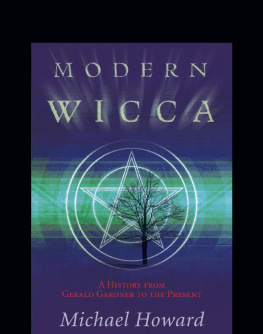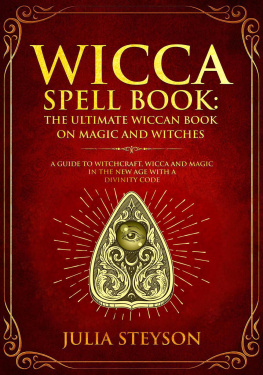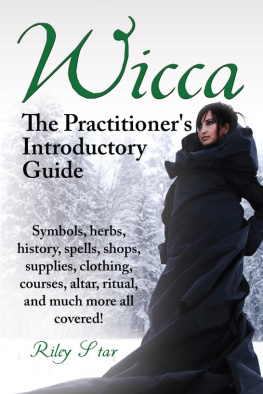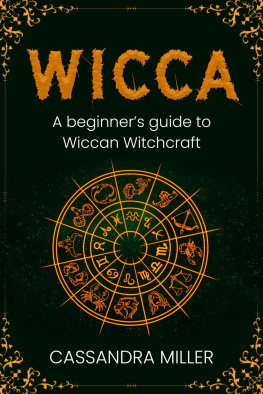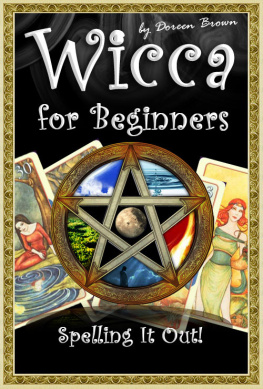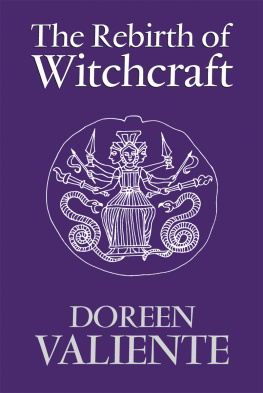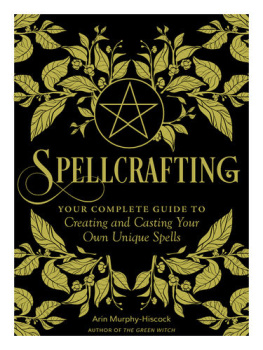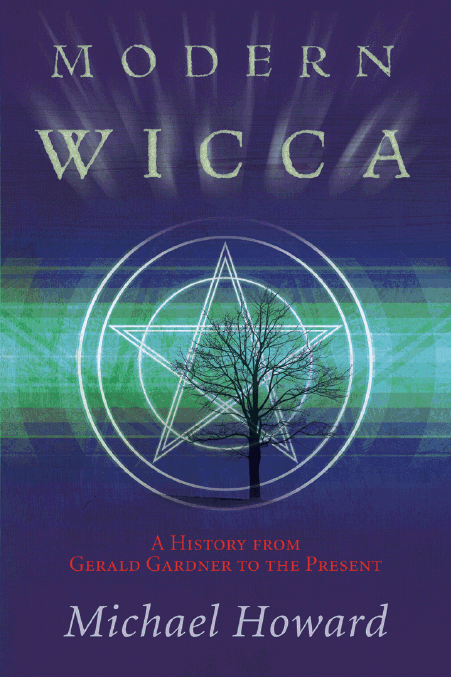

About the Author
Michael Howard is a freelance writer, researcher, and editor specializing in witchcraft, the occult, ancient and modern paganism, mythology, folklore, and general esoteric subjects. Since 1970 he has written numerous articles and book reviews for occult and pagan magazines such as Prediction, Insight, Fate, Destiny, The Hedgewytch, Green Egg, Pagan Dawn, Pentacle, Verdelet, Lamp of Thoth , and New Occult .
He has edited and published The Cauldron , a quarterly journal featuring Wicca, Ancient and Modern Paganism, and Folklore since 1976. He is a member of the Folklore Society, the Royal Stuart Society, the Friends of the Museum of Witchcraft at Boscastle in Cornwall, and an honorary member of the Pagan Federation (UK).
Howard is the author of twenty-seven books, and has five forthcoming. (see the bibliography, pp. 337.


Llewellyn Publications
Woodbury, Minnesota
Modern Wicca: A History from Gerald Gardner to the Present 2009 by Michael Howard.
All rights reserved. No part of this book may be used or reproduced in any matter whatsoever, including Internet usage, without written permission from Llewellyn Publications, except in the form of brief quotations embodied in critical articles and reviews.
As the purchaser of this e-book, you are granted the non-exclusive, non-transferable right to access and read the text of this ebook on screen. The text may not be otherwise reproduced, transmitted, downloaded, or recorded on any other storage device in any form or by any means.
Any unauthorized usage of the text without express written permission of the publisher is a violation of the authors copyright and is illegal and punishable by law.
First e-book edition 2010
E-book ISBN: 9780738722887
Cover art 2009 Murat Domkhokov/iStockphoto (pentagram)
Creatas/PunchStock (tree)
Cover design by Ellen Dahl
Editing by Connie Hill
Llewellyn Publications is an imprint of Llewellyn Worldwide Ltd.
Llewellyn Publications does not participate in, endorse, or have any authority or responsibility concerning private business arrangements between our authors and the public.
Any Internet references contained in this work are current at publication time, but the publisher cannot guarantee that a specific reference will continue or be maintained. Please refer to the publishers website for links to current author websites.
Llewellyn Publications
Llewellyn Worldwide Ltd.
2143 Wooddale Drive
Woodbury, MN 55125
www.llewellyn.com
Manufactured in the United States of America

Dedication
To the memory of Fidelia,
who showed me the Way
all those years ago.

Contents
Part OneBeginnings: 18841940
Part TwoDevelopment: 19411953
Part ThreeExpansion: 19541963
Part FourEvolution: 19641980
Part FiveThe Future: 19812008
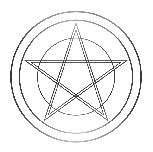
P rofessor Ronald Hutton of the University of Bristol has said that Wicca (i.e., modern neopagan witchcraft) is the only religion that England has given to the world (pers. comm.). Wicca was founded, or perhaps created is a better word, by a retired civil servant, Gerald Brosseau Gardner (18841964) in the 1940s. Gardner had left England as a young man in the early 1900s to work as a tea planter, rubber plantation inspector, and Customs officer in the Far East, where he studied Eastern religions and the magical beliefs and practices of the indigenous peoples of Borneo and Malaysia. On his frequent visits back to England on leave, he attended Spiritualist sances and studied psychic research. In 1936, Gardner retired from the Customs Service and returned home permanently. He became involved in archaeology and naturism (for health reasons), joined the Folklore Society and the Ancient Druid Order, and was ordained as a minister in an unorthodox Christian sect known as the Ancient British Church.
In 1939, Gardner and his wife Donna moved from London to the New Forest area in Hampshire. Once living there, Gardner joined a Rosicrucian group known as the Fellowship of Crotona, and he claimed to have encountered a surviving coven of witches who belonged to it. They invited him to join the Craft, and in September 1939, a few days after World War II began, Gardner was initiated into the witch cult, as he called it. He was eager to tell the world about his amazing discovery, but his fellow witches were not so keen. As one member of the coven told Gardner, if it was discovered in the village what they were, every time a chicken died or a child became sick they would be blamed. They added: Witchcraft doesnt pay for broken windows (Gardner 1954: 10). Reluctantly the witches gave him permission to reveal a little about what they believed and practiced in a fictional form. This Gardner did in his occult novel High Magics Aid , published in 1949.
Around the same time, Gardner founded his own coven on land owned by the Five Acres naturist camp at Brickett Wood in Hertfordshire, just north of London. Because, as Gardner was later to tell his initiate Doreen Valiente, the rituals he had received from the New Forest Coven were fragmentary, he wrote his own version. These were based on standard occult works such as the medieval grimoire known as the Key of Solomon, the writings of the controversial magician Aleister Crowley, known popularly as the Great Beast 666, whom Gardner had met in 1947, and the American folklorist Charles Godfrey Lelands book Aradia: The Gospel of the Witches (1899), based on the teachings of the Italian witch cult in Tuscany.
In 1951, Gardner became the business partner of Cecil Williamson, an ex-tobacco farmer in Africa, pre-war film producer, and wartime MI6 (Secret Intelligence Service) officer, in launching a witchcraft museum at Castletown on the Isle of Man. When Williamson decided to sell up a few years later Gardner took over the museum and ran it until his death. In 1953, Gardner initiated Doreen Valiente into the Craft. She was responsible for rewriting the Book of Shadows (BoS), the ritual manual of Gardners version of witchcraft, including the famous invocation known as the Charge of the Goddess and the Witches Rune chant. A year later Gardners first nonfiction book, Witchcraft Today , was published. This was followed five years later by The Meaning of Witchcraft.
Before his death in 1964, Gardner initiated several more women as Wiccan priestesses, including Patricia Crowther, Monique Wilson, Lois Pearson (Bourne), and Eleanor (Ray) Bone. All these women went on to found their own covens, and Monique Wilson inherited the witchcraft museum on the Isle of Man in Gardners will, which he controversially changed a few days before he died. Wilson eventually sold the collection in the museum in the 1970s to the Ripley Believe It or Not organization in Canada, which then transferred it to the United States for exhibition in their museum on Fishermans Wharf in San Francisco.
Next page
